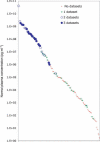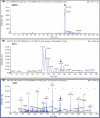Candidate-based proteomics in the search for biomarkers of cardiovascular disease
- PMID: 15611012
- PMCID: PMC1665562
- DOI: 10.1113/jphysiol.2004.080473
Candidate-based proteomics in the search for biomarkers of cardiovascular disease
Abstract
The key concept of proteomics (looking at many proteins at once) opens new avenues in the search for clinically useful biomarkers of disease, treatment response and ageing. As the number of proteins that can be detected in plasma or serum (the primary clinical diagnostic samples) increases towards 1000, a paradoxical decline has occurred in the number of new protein markers approved for diagnostic use in clinical laboratories. This review explores the limitations of current proteomics protein discovery platforms, and proposes an alternative approach, applicable to a range of biological/physiological problems, in which quantitative mass spectrometric methods developed for analytical chemistry are employed to measure limited sets of candidate markers in large sets of clinical samples. A set of 177 candidate biomarker proteins with reported associations to cardiovascular disease and stroke are presented as a starting point for such a 'directed proteomics' approach.
Figures



References
-
- Abbate R, Sofi F, Brogi D, Marcucci R. Emerging risk factors for ischemic stroke. Neurol Sci. 2003;24(Suppl. 1):S11–S12. - PubMed
-
- Adkins JN, Varnum SM, Auberry KJ, Moore RJ, Angell NH, Smith RD, Springer DL, Pounds JG. Toward a human blood serum proteome: analysis by multidimensional separation coupled with mass spectrometry. Mol Cell Proteomics. 2002;1:947–955. - PubMed
-
- American Heart Association. Heart Disease and Stroke Statistics – 2004 Update. Dallas, TX, USA: American Heart Association; 2003.
-
- Akenzua GI, Ihongbe JC, Asemota HN. Alpha-hydroxybutyrate dehydrogenase and the diagnosis of painful crisis in sickle cell anaemia. Afr J Med Med Sci. 1992;21:13–17. - PubMed
Publication types
MeSH terms
Substances
LinkOut - more resources
Full Text Sources
Other Literature Sources
Research Materials

